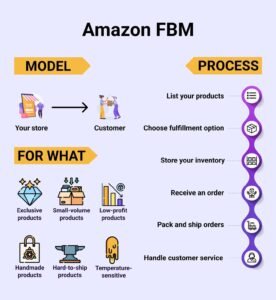Introduction
When it comes to selling on Amazon, two primary fulfillment methods are available: Fulfillment by Amazon (FBA) and Fulfillment by Merchant (FBM). While FBA has garnered much attention, FBM remains a popular choice for many sellers who prefer to handle their own shipping and inventory management. In this article, we’ll delve into the ins and outs of Amazon FBM, exploring its advantages, disadvantages, and best practices.

What is Amazon FBM?
Fulfillment by Merchant (FBM) is a fulfillment method where the seller is responsible for storing inventory, packing orders, and shipping products directly to customers. Unlike Fulfillment by Amazon (FBA), where Amazon takes care of these logistics, FBM allows sellers to maintain full control over their supply chain and customer experience.
For Amazon FBM step by step guidance watch this video
How Amazon FBM Works
- Listing Products: Sellers list their products on Amazon, just as they would with FBA. The difference lies in the fulfillment method selected during the listing process. When choosing FBM, sellers indicate that they will handle all aspects of order fulfillment.
- Inventory Management: With FBM, sellers are responsible for managing their inventory. This means keeping track of stock levels, ensuring products are stored properly, and replenishing inventory as needed. Sellers must be vigilant to avoid running out of stock or overstocking, both of which can negatively impact their business.
- Order Processing: When an order is placed, the seller receives a notification. It’s then up to the seller to pick, pack, and ship the product. This requires efficient systems to ensure that orders are fulfilled promptly and accurately.
- Shipping: Sellers using FBM must choose the appropriate shipping method and carrier, ensuring that the product arrives at the customer’s doorstep within the expected delivery window. Sellers can either charge customers for shipping or offer free shipping as part of their pricing strategy.
- Customer Service: Sellers handle all customer service inquiries related to their products, including returns, refunds, and any issues with shipping. This requires a dedicated customer service process to ensure customer satisfaction.
Advantages of Amazon FBM
- Control Over Fulfillment: FBM allows sellers to have complete control over their fulfillment process. This can be advantageous for businesses that already have a reliable fulfillment system or those that require special handling of their products.
- Lower Fees: FBM can be more cost-effective than FBA, especially for larger or heavier items. Since sellers are not paying for Amazon’s warehousing and fulfillment services, they can often save on fees.
- Customizable Shipping Options: FBM sellers can choose from a variety of shipping options, allowing for greater flexibility in delivery times and costs. This can be particularly beneficial for sellers with specialized shipping needs.
- Direct Customer Interaction: By handling customer service directly, FBM sellers can build stronger relationships with their customers. This direct interaction can lead to better customer satisfaction and potentially higher repeat business.
- Better for Multi-Channel Sellers: If a seller operates on multiple platforms (e.g., eBay, Shopify), FBM allows them to use a centralized fulfillment system for all orders, streamlining operations.
Disadvantages of Amazon FBM
- Increased Workload: Managing inventory, packing orders, and handling shipping can be time-consuming and labor-intensive. This is especially true for high-volume sellers, who may struggle to keep up with demand.
- Shipping and Handling Costs: While FBM can save on Amazon fees, it often comes with higher shipping and handling costs. Sellers must negotiate rates with carriers and manage shipping logistics, which can add complexity.
- Potential for Lower Sales: Products fulfilled by Amazon (FBA) are often eligible for Prime shipping, which is a significant selling point for many customers. FBM sellers may find it harder to compete with FBA listings, especially when customers prioritize fast, free shipping.
- Higher Risk of Negative Feedback: Since FBM sellers are responsible for the entire customer experience, any issues with shipping or product quality can lead to negative feedback. This can impact a seller’s rating and visibility on Amazon.
- Complex Returns Process: Handling returns and refunds can be more challenging with FBM. Sellers need to establish a clear returns process and manage the logistics of receiving and restocking returned items.
Best Practices for Amazon FBM Success
- Efficient Inventory Management: Invest in inventory management software to keep track of stock levels, avoid overselling, and manage restocking efficiently. This can help prevent stockouts and ensure timely fulfillment.
- Streamlined Order Fulfillment: Develop a streamlined order processing system to ensure that orders are packed and shipped quickly and accurately. Consider automating parts of the fulfillment process where possible.
- Competitive Shipping Rates: Work with multiple carriers to negotiate competitive shipping rates. Offering free or low-cost shipping can be a strong selling point, even if it means absorbing some of the shipping costs.
- Excellent Customer Service: Provide top-notch customer service to address any issues promptly and professionally. Responding quickly to inquiries and resolving problems efficiently can help maintain a positive seller rating.
- Optimize Listings for Visibility: Ensure that product listings are optimized for search on Amazon. This includes using relevant keywords, high-quality images, and detailed product descriptions. Positive customer reviews and ratings can also enhance visibility.
- Monitor Performance Metrics: Regularly review performance metrics such as order defect rate, late shipment rate, and feedback score. Keeping these metrics within Amazon’s standards is crucial for maintaining a good seller standing.
Conclusion
Amazon FBM offers a viable alternative to FBA, particularly for sellers who value control over their fulfillment process and want to reduce fees. However, it comes with its own set of challenges, including increased workload and potential for lower sales. By following best practices and staying vigilant, FBM sellers can successfully manage their operations and thrive in the competitive Amazon marketplace. Whether you choose FBM or FBA, understanding the nuances of each fulfillment method is key to making an informed decision that aligns with your business goals.

